Preface
This document describes two functional modules of the CUBA platform, which display charts and geographic maps respectively. These subsystems are implemented in the same base project – charts – and thus can only be included in an application project together.
Charts and map display functionality is currently available only for the web client.
Target Audience
This manual is intended for developers building applications using CUBA platform. It is assumed that the reader is familiar with the Developer’s Manual, which is available at https://www.cuba-platform.com/manual.
Additional Materials
This guide, as well as any other documentation on CUBA platform, is available at https://www.cuba-platform.com/manual.
CUBA charts display subsystem implementation is based on AmCharts library, therefore familiarity with this library may be beneficial. See http://www.amcharts.com.
Feedback
If you have any feedback or would like to suggest an improvement for this manual, please contact support at https://www.cuba-platform.com/support/topics.
If you find an error in this document, please specify the section number and attach a small piece of surrounding text to help us find it.
1. Displaying Charts
CUBA platform charts display subsystem supports various chart types: pie charts, line plots, bubble charts, radar charts, funnel charts, stock charts and more. It is also possible to export charts. Most chart types support zoom and scrolling. The charts are supported in web client only.
AmCharts library which is the basis of the chart display subsystem is distributed under a license, which allows its free use if you keep the link to the library website. Alternatively, you can purchase an AmCharts license for your project and remove the link.
1.1. Add Charts Dependency
To use charts in your project, activate the charts item in the Base projects list on the Project properties page of CUBA Studio.
1.2. Configuring Charts
Charts are displayed using the Chart component acting as a universal canvas. Chart type is defined by the configuration property, which has the AbstractChart type.
Charts can be described in a screen XML-descriptor. To do this, you should connect the corresponding namespace:
<window xmlns="http://schemas.haulmont.com/cuba/window.xsd"
xmlns:chart="http://schemas.haulmont.com/charts/charts.xsd"
...>XML elements corresponding to different chart types:
-
chart:xyChart- XYChart -
chart:serialChart- SerialChart -
chart:pieChart- PieChart -
chart:funnelChart- FunnelChart -
chart:gaugeChart- AngularGaugeChart -
chart:radarChart- RadarChart -
chart:ganttChart- GanttChart -
chart:stockChart- StockChart
Each chart type has its own set of attributes and methods, which replicate the functionality of the corresponding charts from AmCharts library. Documentation on the properties and methods of the charts is available at docs.amcharts.com/3/javascriptcharts.
Any configuration attribute can be set to null; in this case the system will use the default value (except the cases specified in the AmCharts documentation).
1.3. Connecting Data
There are two ways how you can pass data to a chart: through the DataProvider interface or using the datasource mechanism.
-
The
DataProviderinterface has a standard implementation:ListDataProviderclass. It contains a list ofDataIteminstances from which the data for the chart will be taken. There are several standard implementations ofDataIteminterface:-
EntityDataItemtakes an instance of any entity. -
MapDataItemis a set of key-value pairs. -
SimpleDataItemtakes an instance of anypublicclass.
-
An instance of DataProvider is passed to the setDataProvider() method of chart configuration. This approach to providing chart data is the most universal, but it requires creating instances of DataProvider and DataItem in a screen controller.
-
A
CollectionDatasourcetype datasource can be assigned to aChartcomponent by invoking thesetDatasource()method. This approach requires an entity that will represent chart data. It may be convenient when such entity already exists in the application data model and also when chart data should be displayed as a table.
Example of Working with Charts illustrates both approaches to providing chart data.
Entity properties or the values contained in an instance of DataProvider which are used for display purposes are defined in the chart attributes. The set of chart attributes may differ for different chart types. For example, for the chart:pieChart component, you should define the valueField and titleField attributes. The following types are allowed for attribute values: Integer, Long, Double, String, Boolean, Date.
Dynamic addition of data to an existing chart is supported for both the datasource and the data provider mechanisms.
1.4. Events
It is possible to configure handling of different event types. The following listener types are available:
-
AxisZoomListener- chart axis scaling. -
ChartClickListener- click on the canvas. -
RightClickListener- right click on the canvas. -
CursorPeriodSelectListener- selection of the display period with a cursor. -
CursorZoomListener- scaling of the chart area with a cursor. -
GraphClickListener- click on a graph. -
GraphItemClickListener- click on a graph item. -
LegendItemHideListener- hiding a legend item. -
LegendItemShowListener- showing a legend item. -
LegendItemClickListener- click on a legend item. -
SliceClickListener- click on a slice in a pie chart. -
SliceRightClickListener- right-click on a slice in a pie chart. -
SlicePullInListener- shift of a slice of a pie chart into the chart. -
SlicePullOutListener- shift of a slice of a pie chart out of the chart. -
ZoomListener- scaling of the canvas.
Event handling examples are available in Using Events.
1.5. Example of Working with Charts
This chapter shows how you can use the chart display subsystem.
1.5.1. Setting up the Application Project
-
Run CUBA Studio, create new project and name it
sampler. -
Open Project properties → Edit and include the charts project into the list of Base projects; save changes. Confirm when Studio will suggest recreating Gradle scripts.
-
Select Run → Deploy. At this point, the application will be assembled and deployed to the Tomcat application server located at
build/tomcat. -
Select Build → Create or update IDEA project files to create project files for IntelliJ IDEA.
Once the steps above are complete, the chart display functionality will be connected to the application and ready to be used.
1.5.2. Creating Chart with Data from an Entity
For the first example we will create the chart similar to 3D Stacked Column Chart from AmCharts demos. This chart will retrieve data from a database, so the datasource attribute has to be defined. The JavaScript source code which amCharts use to define such chart is as follows:
var chart = AmCharts.makeChart("chartdiv", {
"theme": "light",
"type": "serial",
"dataProvider": [{
"country": "USA",
"year2004": 3.5,
"year2005": 4.2
}, {
"country": "UK",
"year2004": 1.7,
"year2005": 3.1
}, {
"country": "Canada",
"year2004": 2.8,
"year2005": 2.9
}, {
"country": "Japan",
"year2004": 2.6,
"year2005": 2.3
}, {
"country": "France",
"year2004": 1.4,
"year2005": 2.1
}, {
"country": "Brazil",
"year2004": 2.6,
"year2005": 4.9
}, {
"country": "Russia",
"year2004": 6.4,
"year2005": 7.2
}, {
"country": "India",
"year2004": 8,
"year2005": 7.1
}, {
"country": "China",
"year2004": 9.9,
"year2005": 10.1
}],
"valueAxes": [{
"stackType": "3d",
"unit": "%",
"position": "left",
"title": "GDP growth rate",
}],
"startDuration": 1,
"graphs": [{
"balloonText": "GDP grow in [[category]] (2004): <b>[[value]]</b>",
"fillAlphas": 0.9,
"lineAlpha": 0.2,
"title": "2004",
"type": "column",
"valueField": "year2004"
}, {
"balloonText": "GDP grow in [[category]] (2005): <b>[[value]]</b>",
"fillAlphas": 0.9,
"lineAlpha": 0.2,
"title": "2005",
"type": "column",
"valueField": "year2005"
}],
"plotAreaFillAlphas": 0.1,
"depth3D": 60,
"angle": 30,
"categoryField": "country",
"categoryAxis": {
"gridPosition": "start"
},
"export": {
"enabled": true
}
});1.5.2.1. Creating an Entity
-
Open the Entities tab in CUBA Studio and click New entity button.
-
In the New entity dialog type
CountryGrowthin the Class name field, chooseNot persistentfor Entity type and click OK button. -
Using Entity Designer add attributes:
-
countryof the typeString -
year2014of the typeDouble -
year2015of the typeDouble
-
-
Open the Source tab to see generated source code:
package com.company.sampler.entity; import com.haulmont.chile.core.annotations.MetaClass; import com.haulmont.chile.core.annotations.MetaProperty; import com.haulmont.cuba.core.entity.AbstractNotPersistentEntity; @MetaClass(name = "sampler$CountryGrowth") public class CountryGrowth extends AbstractNotPersistentEntity { @MetaProperty protected String country; @MetaProperty protected Double year2014; @MetaProperty protected Double year2015; public void setCountry(String country) { this.country = country; } public String getCountry() { return country; } public void setYear2014(Double year2014) { this.year2014 = year2014; } public Double getYear2014() { return year2014; } public void setYear2015(Double year2015) { this.year2015 = year2015; } public Double getYear2015() { return year2015; } }This class describes non-persistent entity. An instance of this class contains the number of the country GDP growth rate for 2014 and 2015 years.
-
Click OK button to save the entity and close the designer screen.
-
In the Entities tab click Generate DB scripts button and save scripts.
-
Create the application database by selecting Run → Create database.
1.5.2.2. Creating Chart
1.5.2.2.1. Screen XML Descriptor
Open the Screens tab in CUBA Studio and create a screen in the web module. Enter the value com/company/sampler/web/screens/column3d-chart.xml in the Descriptor field. The fields - Id, Controller Name and Messages Pack will be filled in with appropriate values. Save changes. Open the XML tab and replace its content with the following code:
<?xml version="1.0" encoding="UTF-8" standalone="no"?>
<window xmlns="http://schemas.haulmont.com/cuba/window.xsd"
caption="msg://caption"
class="com.company.sampler.web.screens.Column3dChart"
messagesPack="com.company.sampler.web.screens"
xmlns:chart="http://schemas.haulmont.com/charts/charts.xsd">
<dsContext>
<collectionDatasource id="countryGrowthDs"
class="com.company.sampler.entity.CountryGrowth"
refreshMode="NEVER"
view="_local">
<query>
<![CDATA[select e from sampler$CountryGrowth e]]>
</query>
</collectionDatasource>
</dsContext>
<layout>
<chart:serialChart id="chart"
angle="30"
categoryField="country"
datasource="countryGrowthDs"
depth3D="60"
height="100%"
plotAreaFillAlphas="0.1"
startDuration="1"
width="100%">
<chart:categoryAxis gridPosition="START"/>
<chart:valueAxes>
<chart:axis position="LEFT"
stackType="BOX_3D"
title="GDP growth rate"
unit="%"/>
</chart:valueAxes>
<chart:graphs>
<chart:graph id="graph2014"
balloonText="GDP grow in [[category]] (2014): <b>[[value]]</b>"
fillAlphas="0.9"
lineAlpha="0.2"
title="2014"
type="COLUMN"
valueField="year2014"/>
<chart:graph id="graph2015"
balloonText="GDP grow in [[category]] (2015): <b>[[value]]</b>"
fillAlphas="09."
lineAlpha="0.2"
title="2015"
type="COLUMN"
valueField="year2015"/>
</chart:graphs>
<chart:export/>
</chart:serialChart>
</layout>
</window>The root element of the screen descriptor contains a new xmlns:chart attribute:
<window xmlns:chart="http://schemas.haulmont.com/charts/charts.xsd"
...
>The chart retrieves data from the countryGrowthDs datasource defined in the datasource attribute. Names and values are displayed using the country, year2014 and year2015 attributes of the CountryGrowth entity; the list of instances for this entity is stored in the datasource.
The chart:serialChart component contains the following attributes:
-
angle- defines the chart angle. May have a value from0to90. -
balloonText- defines text for the tooltip that appears when hovering over a column. You can use the following tags:[[value]],[[title]],[[persents]],[[description]], as well as keys from theDataItemlisted in aDataProviderinstance, or names of the entity attributes from the datasource. To usehtmltags you must escape them. -
depth3D- chart thickness. When used in combination with theangleattribute, helps to create a 3D effect. -
plotAreaFillAlphas- opacity of the plot area. -
startDuration- duration of the animation, in seconds. -
categoryField- a key from the set of pairs contained in theDataItemobjects listed in aDataProviderinstance; this key is used to determine the labels for the category axis.
The chart:serialChart component contains the following elements:
-
chart:categoryAxis- an element that describes the category axis.-
The
gridPositionattribute specifies if a grid line is placed on the center of a cell or on the beginning of a cell.
-
-
chart:valueAxes- an element that defines vertical value axes. In our case, only one vertical axis is used; the axis is described by thechart:axiselement.-
The
positionattribute defines position of the value axis relative to the chart. -
Setting
stackTypetoBOX_3Dmakes the chart display columns one behind the other.
-
-
chart:graphs- an element that contains the collection ofchart:graphelements; the graph is described by thechart:graphelement.-
The
typeattribute defines the type of the graph and can be: line, column, step line, smoothed line, olhc and candlestick. -
The
valueFieldattribute defines a key from the list of pairs contained in theDataItemobjects listed in aDataProviderinstance; this key is used to determine the value. -
The
fillAlphasattribute defines opacity of fill. -
The
lineAlphaattribute defines opacity of the line (or column border). Value range is 0 - 1.
-
-
chart:export– an optional element that enables chart export.
1.5.2.2.2. Screen Controller
Open the Controller tab and replace its content with the following code:
package com.company.sampler.web.screens;
import com.company.sampler.entity.CountryGrowth;
import com.haulmont.cuba.gui.components.AbstractWindow;
import com.haulmont.cuba.gui.data.CollectionDatasource;
import javax.inject.Inject;
import java.util.Map;
import java.util.UUID;
public class Column3dChart extends AbstractWindow {
@Inject
private CollectionDatasource<CountryGrowth, UUID> countryGrowthDs;
@Override
public void init(Map<String, Object> params) {
countryGrowthDs.refresh();
countryGrowthDs.includeItem(countryGrowth("USA", 3.5, 4.2));
countryGrowthDs.includeItem(countryGrowth("UK", 1.7, 3.1));
countryGrowthDs.includeItem(countryGrowth("Canada", 2.8, 2.9));
countryGrowthDs.includeItem(countryGrowth("Japan", 2.6, 2.3));
countryGrowthDs.includeItem(countryGrowth("France", 1.4, 2.1));
countryGrowthDs.includeItem(countryGrowth("Brazil", 2.6, 4.9));
countryGrowthDs.includeItem(countryGrowth("Russia", 6.4, 7.2));
countryGrowthDs.includeItem(countryGrowth("India", 8.0, 7.1));
countryGrowthDs.includeItem(countryGrowth("China", 9.9, 10.1));
}
private CountryGrowth countryGrowth(String country, double year2014, double year2015) {
CountryGrowth cg = new CountryGrowth();
cg.setCountry(country);
cg.setYear2014(year2014);
cg.setYear2015(year2015);
return cg;
}
}The init(Map<String, Object> params) method populates the countryGrowthDs datasource with the data. The refresh() method initializes the datasource. This method should be invoked regardless of the refreshMode="NEVER" attribute declared in the XML-descriptor.
1.5.2.3. Result
-
Open the Main Menu tab in CUBA Studio and click edit button for
web-menu.xml. -
Choose
applicationitem and click new button. -
In Create menu item dialog choose
column3d-chartfor id field and click add. -
Select Run → Start application server.
After logging in and opening the screen from the application menu you will see the chart like below:

1.5.3. Creating Chart with Data from DataProvider
This chart retrieves data through the DataProvider created in the controller, so the datasource attribute is not defined.
1.5.3.1. Creating Chart
1.5.3.1.1. Screen XML Descriptor
Open the Screens tab in CUBA Studio and create a screen in the web module. Enter the value com/company/sampler/web/screens/stackedarea-chart.xml in the Descriptor field. The fields - Id, Controller Name and Messages Pack will be filled in with appropriate values. Save changes. Open the XML tab and replace its content with the following code:
<?xml version="1.0" encoding="UTF-8" standalone="no"?>
<window xmlns="http://schemas.haulmont.com/cuba/window.xsd"
caption="msg://caption"
class="com.company.sampler.web.screens.StackedAreaChart"
messagesPack="com.company.sampler.web.screens"
xmlns:chart="http://schemas.haulmont.com/charts/charts.xsd">
<layout>
<chart:serialChart id="chart"
categoryField="year"
height="100%"
marginLeft="0"
marginTop="10"
plotAreaBorderAlpha="0"
width="100%">
<chart:chartCursor cursorAlpha="0"/>
<chart:legend equalWidths="false"
periodValueText="total: [[value.sum]]"
position="TOP"
valueAlign="LEFT"
valueWidth="100"/>
<chart:valueAxes>
<chart:axis gridAlpha="0.07"
position="LEFT"
stackType="REGULAR"
title="Traffic incidents"/>
</chart:valueAxes>
<chart:graphs>
<chart:graph fillAlphas="0.6"
hidden="true"
lineAlpha="0.4"
title="Cars"
valueField="cars"/>
<chart:graph fillAlphas="0.6"
lineAlpha="0.4"
title="Motorcycles"
valueField="motorcycles"/>
<chart:graph fillAlphas="0.6"
lineAlpha="0.4"
title="Bicycles"
valueField="bicycles"/>
</chart:graphs>
<chart:categoryAxis axisColor="#DADADA"
gridAlpha="0.07"
startOnAxis="true"/>
<chart:export/>
</chart:serialChart>
</layout>
</window>The root element of the screen descriptor contains a new xmlns:chart attribute:
<window xmlns:chart="http://schemas.haulmont.com/charts/charts.xsd"
...
>chart:serialChart attributes:
-
categoryField- a key from the set of pairs contained in theDataItemobjects listed in aDataProviderinstance; this key is used to determine the labels for the category axis.
The elements of chart:serialChart:
-
chart:chartCursor- an optional element adding a cursor to the chart; the cursor follows the mouse pointer and shows a tooltip with the value of the corresponding point on a chart.-
The
cursorAlphaattribute defines opacity of the cursor line.
-
-
chart:legend- an element that defines the chart legend.-
The
positionattribute defines the location of the legend relative to the chart. -
The
equalWidthsattribute specifies if each of legend entry should be equal to the most wide entry. -
The
periodValueTextattribute defines the text which will be displayed in the value portion of the legend when user is not hovering above any data point. The tags should be made out of two parts - the name of a field (value / open / close / high / low) and the value of the period you want to be show - open / close / high / low / sum / average / count. -
The
valueAlignattribute defines alignment of the value text. Possible values are "left" and "right". -
The
valueWidthattribute defines width of the value text.
-
-
chart:valueAxes- an element that defines vertical value axes. In our case, only one vertical axis is used; the axis is described by thechart:axiselement.-
The
positionattribute defines position of the value axis relative to the chart. -
The
titleattribute defines the title of the value axis. -
Setting
stackTypetoREGULARmakes the chart display a rolling value. Setting this attribute tononerefers to a non-rolling value. -
The
gridAlphadefines opacity of grid lines.
-
-
chart:graphs- an element that contains the collection ofchart:graphelements; the graph is described by thechart:graphelement.-
The
typeattribute defines the type of the graph and can be: line, column, step line, smoothed line, olhc and candlestick. -
The
valueFieldattribute defines a key from the list of pairs contained in theDataItemobjects listed in aDataProviderinstance; this key is used to determine the value. -
The
fillAlphasattribute defines opacity of fill. -
The
lineAlphaattribute defines opacity the line (or column border). Value range is 0 - 1. -
The
hiddenattribute specifies whether the graph is hidden.
-
-
chart:categoryAxis- an element that describes the category axis.-
Setting
startOnAxistotruecauses drawing the chart right from the value axis. The default value for this attribute isfalse. In this case, there will be a small gap between the value axis and the chart. -
The
gridAlphaattribute defines opacity of grid lines. -
The
axisColorattribute defines axis color.
-
-
chart:export– an optional element that enables chart export.
1.5.3.1.2. Screen Controller
Open the Controller tab and replace its content with the following code:
package com.company.sampler.web.screens;
import com.haulmont.charts.gui.amcharts.model.charts.SerialChart;
import com.haulmont.charts.gui.amcharts.model.data.DataItem;
import com.haulmont.charts.gui.amcharts.model.data.ListDataProvider;
import com.haulmont.charts.gui.amcharts.model.data.MapDataItem;
import com.haulmont.charts.gui.components.charts.Chart;
import com.haulmont.cuba.gui.components.AbstractWindow;
import javax.inject.Inject;
import java.util.Map;
public class StackedAreaChart extends AbstractWindow {
@Inject
private Chart chart;
@Override
public void init(Map<String, Object> params) {
ListDataProvider dataProvider = new ListDataProvider();
dataProvider.addItem(transportCount(1994, 1587, 650, 121));
dataProvider.addItem(transportCount(1995, 1567, 683, 146));
dataProvider.addItem(transportCount(1996, 1617, 691, 138));
dataProvider.addItem(transportCount(1997, 1630, 642, 127));
dataProvider.addItem(transportCount(1998, 1660, 699, 105));
dataProvider.addItem(transportCount(1999, 1683, 721, 109));
dataProvider.addItem(transportCount(2000, 1691, 737, 112));
dataProvider.addItem(transportCount(2001, 1298, 680, 101));
dataProvider.addItem(transportCount(2002, 1275, 664, 97));
dataProvider.addItem(transportCount(2003, 1246, 648, 93));
dataProvider.addItem(transportCount(2004, 1318, 697, 111));
dataProvider.addItem(transportCount(2005, 1213, 633, 87));
dataProvider.addItem(transportCount(2006, 1199, 621, 79));
dataProvider.addItem(transportCount(2007, 1110, 210, 81));
dataProvider.addItem(transportCount(2008, 1165, 232, 75));
dataProvider.addItem(transportCount(2009, 1145, 219, 88));
dataProvider.addItem(transportCount(2010, 1163, 201, 82));
dataProvider.addItem(transportCount(2011, 1180, 285, 87));
dataProvider.addItem(transportCount(2012, 1159, 277, 71));
SerialChart serialChart = (SerialChart) chart.getConfiguration();
serialChart.setDataProvider(dataProvider);
}
private DataItem transportCount(int year, int cars, int motorcycles, int bicycles) {
MapDataItem item = new MapDataItem();
item.add("year", year);
item.add("cars", cars);
item.add("motorcycles", motorcycles);
item.add("bicycles", bicycles);
return item;
}
}The init(Map<String, Object> params) method submits data to the chart as a rolling value. This type of charts shows the ratio of separate parts to their total value.
1.5.3.2. Result
-
Open the Main Menu tab in CUBA Studio and click edit button for
web-menu.xml. -
Choose
applicationitem and click new button. -
In Create menu item dialog choose
stackedarea-chartfor id field and click add. -
Select Run → Start application server.
After logging in and opening the screen from the application menu you will see the chart like below:

1.5.4. Using Events
Let us consider the use of events. We will add handling of a graph item click to the screen created in Creating Chart. Open the screen controller in the IDE and inject the chart:
@Inject
private Chart chart;Then add a listener at the bottom of the init(Map<String, Object> params) method:
chart.addGraphItemClickListener(event -> {
CountryGrowth countryGrowth = (CountryGrowth) event.getItem();
String message = String.format("GDP grow in %s (%s): %.1f%%",
countryGrowth.getCountry(),
event.getGraphId().substring(5),
"graph2014".equals(event.getGraphId()) ? countryGrowth.getYear2014() : countryGrowth.getYear2015());
showNotification(message, NotificationType.HUMANIZED_HTML);
});To see the results, rebuild the project using Run → Restart application server and log in to the system. Open the screen and click one of the columns.
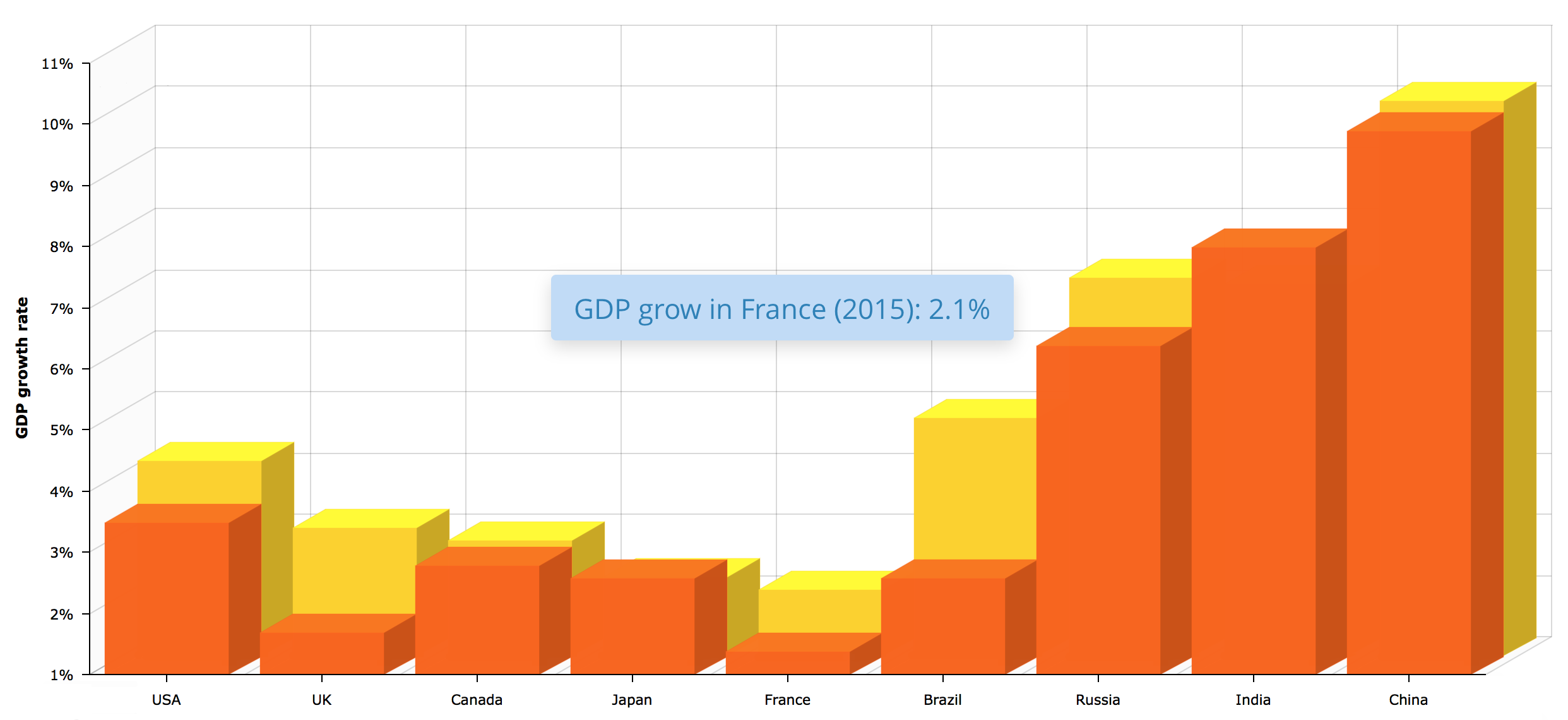
1.6. Chart Types
There are several chart types supported by CUBA platform.

1.6.1. SerialChart
The SerialChart component allows you to create line, area, column, bar, step line, smoothed line, candlestick and OHLC charts. The charts support multiple axes with simple or logarithmic scales, the data points can be displayed at equal/irregular intervals or on timeline basis.


1.6.3. XYChart
The XYChart component allows you to create XY/bubble/scatter charts. The charts support multiple axes with simple or logarithmic scales.

1.6.4. FunnelChart
The FunnelChart component allows you to create funnel/pyramid charts.

1.6.5. RadarChart
The RadarChart component allows you to create radar/polar charts.

1.6.6. AngularGaugeChart
The AngularGaugeChart component allows you to create gauge charts.

1.6.8. StockChartGroup
The StockChartGroup component allows you to create stock charts.
Stock chart supports multiple data sets and has a ready to use data set selector. Data sets might be compared one to another.

Stock chart can display a different kind of annotations on the graph or on the axis. These annotations are called stock events.

Stock chart can support any number of stock panels. Each Stock Panel can have any number of graphs. Each Stock Panel is a separate serial chart and is based on SerialChart and so it can do anything this chart can.

1.7. Replacing AmCharts Version
An instance of AmCharts library included in CUBA platform can be replaced with another one. To do this:
-
Download charts and stock charts from AmCharts site.
-
Merge
amchartsfolder from both archives into one. -
Copy
amchartsfolder to{project.rootDir}/modules/web/web/VAADIN/resources -
Redeploy the application.
To use new attributes added in a new version you need to set custom JSON in your screen controller as shown below.
CubaAmchartsScene cubaAmchartsScene = (CubaAmchartsScene) WebComponentsHelper.unwrap(chart);
cubaAmchartsScene.setJson("{\"valueScrollbar\":{\"autoGridCount\":true}}");2. Displaying Maps
CUBA platform map display subsystem is based on integration with a third-party map service provider. Currently, only Google Maps service is supported.
2.1. Map Display Capabilities
-
Response to events:
-
Mouse click.
-
Map pan and zoom.
-
Marker click and drag.
-
Close pop-up window.
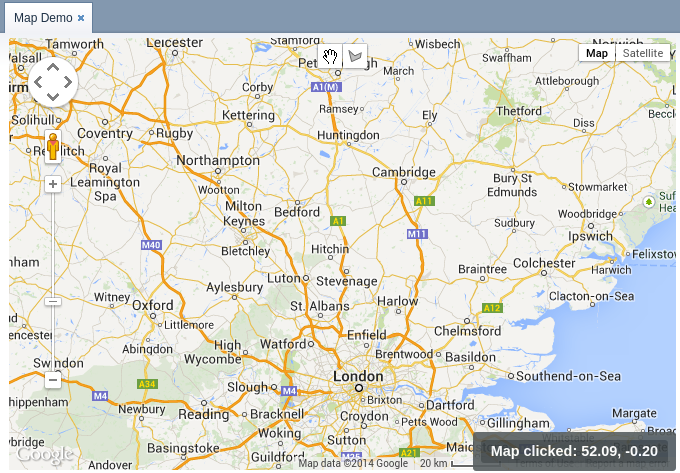
-
-
Adding markers. Marker may be either fixed or draggable by user. Markers can process mouse clicks and send corresponding events to the screen code.
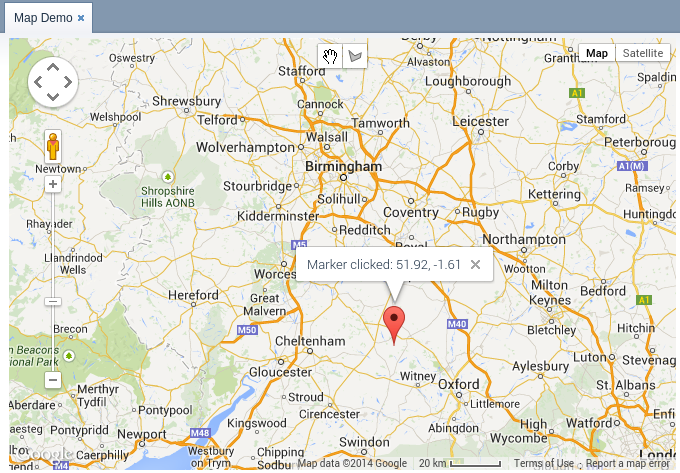
-
Displaying polylines and polygons.
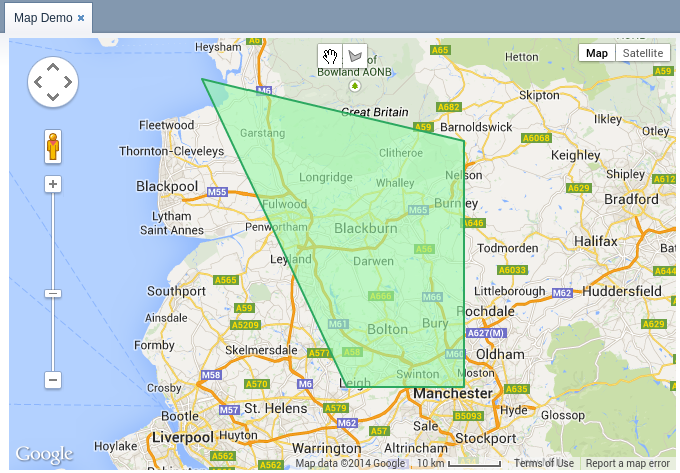
-
Drawing polygons.
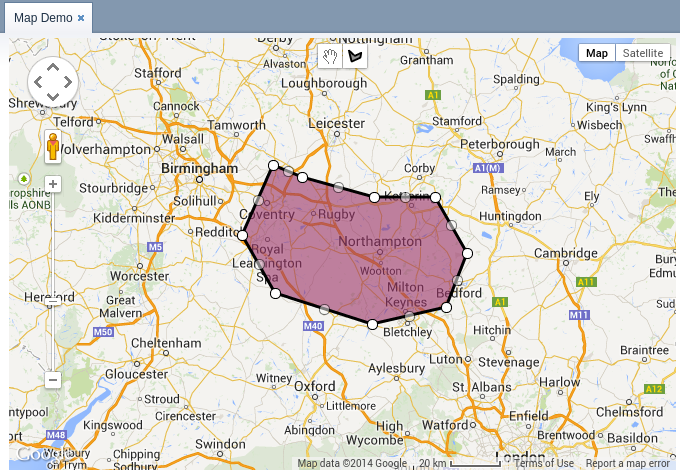
-
Heat map rendering.
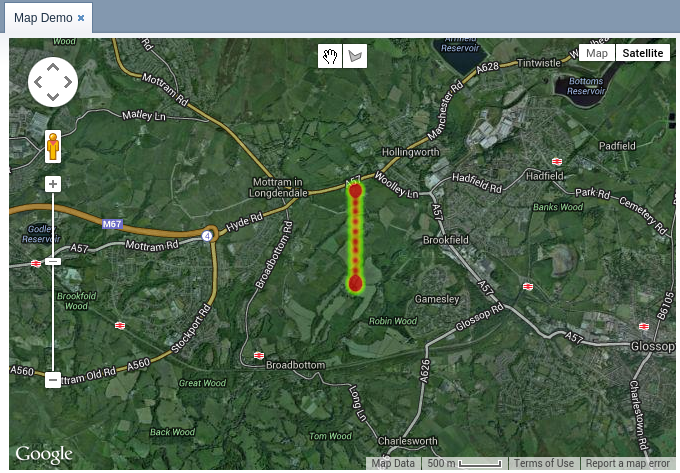
2.2. Setting up Application Project
In order to display maps in your application, you should include the charts base project, as it was described for the chart display subsystem. Additionally, you should define the following application properties for the Web Client block:
-
One of the following parameters (see detailed information on these parameters in the Google Maps API documentation):
-
charts.map.apiKey- a browser key. -
charts.map.clientId- a client ID.
-
-
Optional parameters:
-
charts.map.defaultZoom- default zoom level for the map. -
charts.map.defaultLatitude- default latitude of the map center point. -
charts.map.defaultLongitude- default longitude of the map center point.
-
Example of a web-app.properties file:
charts.map.apiKey = my_key
charts.map.defaultZoom = 13.0
charts.map.defaultLatitude = 51.5001
charts.map.defaultLongitude = -0.12622.3. MapViewer Component
You can display maps in your application screens using the com.haulmont.charts.gui.components.map.MapViewer component.
To add the component, declare the chart namespace in the root element of the screen XML descriptor:
<window xmlns="http://schemas.haulmont.com/cuba/window.xsd"
xmlns:chart="http://schemas.haulmont.com/charts/charts.xsd"
...>XML-name of the component: mapViewer. Component declaration example:
<layout>
<vbox id="mapBox" height="100%">
<chart:mapViewer id="map" width="100%" height="100%"/>
</vbox>
</layout>You can define the following component parameters in the screen XML-descriptor:
-
id,width,height- standard component properties. -
mapType- map type corresponding to theMapViewer.Type:roadmap,satellite,hybrid,terrain. Default isroadmap. -
vendor- map service provider. Currently the only supported value isgoogle.
Main configuration of the map and its components is performed in a screen controller. For this, you only need to inject the component declared in the XML-descriptor:
@Inject
private MapViewer map;
@Override
public void init(Map<String, Object> params) {
GeoPoint center = map.createGeoPoint(53.490905, -2.249558);
map.setCenter(center);
}-
Map configuration methods:
-
setZoom()- sets the map zoom level. -
setCenter()- sets the map center point. -
setVisibleAreaBoundLimitsEnabled()- enables visible area limitation mode. -
setVisibleAreaBoundLimits()- sets boundaries of the visible area of the map. -
fitToBounds()- sets the minimum map zoom as the one which will be sufficient to show in full an area limited by north-eastern and south-western coordinates. -
setMaxZoom()- sets the maximum available zoom level. -
setMinZoom()- sets the minimum available zoom level. -
setDraggable()- enables/disables map dragging mode. -
setKeyboardShortcutsEnabled()- enables/disables keyboard shortcuts. -
setScrollWheelEnabled()- enables/disables map zoom with a mouse scroll wheel. -
setMapType()- defines map type.
-
-
Map component interfaces (can be found in
com.haulmont.charts.gui.map.modelpackage):-
GeoPoint- an auxiliary component, which is not displayed on the map. This component can be used to set such map parameters as the center point, boundaries, or to create more complex map components. The object can be created using thecreateGeoPoint()`method of the `MapViewerinterface. For example:GeoPoint center = map.createGeoPoint(53.490905, -2.249558); map.setCenter(center); -
Marker- a component that marks a location on the map. By default, a standard icon of the map service vendor is used. You can use thecreateMarker()andaddMarker()`methods of the `MapViewerinterface to create this object and put it on a map. For example:Marker marker = map.createMarker("My place", map.createGeoPoint(53.590905, -2.249558), true); marker.setClickable(true); map.addMarker(marker); -
Polyline- a component that displays a polyline. You can use thecreatePolyline()andaddPolyline()methods of theMapViewerinterface to create this object and put it on a map. For example:List<GeoPoint> coordinates = new ArrayList<>(); coordinates.add(map.createGeoPoint(53.49, -2.54)); coordinates.add(map.createGeoPoint(53.49, -2.22)); coordinates.add(map.createGeoPoint(53.89, -2.22)); coordinates.add(map.createGeoPoint(53.99, -2.94)); Polyline polyline = map.createPolyline(coordinates); map.addPolyline(polyline); -
Polygon- a component that displays a polygon. You can use thecreatePolygon()andaddPolygonOverlay()methods of theMapViewerinterface to create this object and put it on a map. For example:List<GeoPoint> coordinates = new ArrayList<>(); coordinates.add(map.createGeoPoint(53.49, -2.54)); coordinates.add(map.createGeoPoint(53.49, -2.22)); coordinates.add(map.createGeoPoint(53.89, -2.22)); coordinates.add(map.createGeoPoint(53.99, -2.94)); Polygon p = map.createPolygon(coordinates, "#9CFBA9", 0.6, "#2CA860", 1.0, 2); map.addPolygonOverlay(p); -
InfoWindow- a map component that displays information in a pop-up window. You can use thecreateInfoWindow()andopenInfoWindow()methods of theMapViewerinterface to create this object and put it on a map. For example:InfoWindow w = map.createInfoWindow("Some text"); map.openInfoWindow(w);Information window can be tied to a marker, for example:
map.addMarkerClickListener(new MarkerClickListener() { @Override public void onClick(MarkerClickEvent event) { Marker marker = event.getMarker(); String caption = String.format("Marker clicked: %.2f, %.2f", marker.getPosition().getLatitude(), marker.getPosition().getLongitude()); InfoWindow w = map.createInfoWindow(caption, marker); map.openInfoWindow(w); } }); -
HeatMapLayer- a map layer showing a heat map intended to display data density distribution across different geopoints. Data density is highlighted with color. By default, regions with higher points density are displayed in red and regions with lower density – in green. You can use thecreateHeatMapLayer()andaddHeatMapLayer()methods of theMapViewerinterface to create this object and put it on a map. For example:HeatMapLayer heatMapLayer = map.createHeatMapLayer(); List<GeoPoint> data = new ArrayList<>(); data.add(map.createGeoPoint(53.450, -2.00)); data.add(map.createGeoPoint(53.451, -2.00)); data.add(map.createGeoPoint(53.452, -2.00)); data.add(map.createGeoPoint(53.453, -2.00)); data.add(map.createGeoPoint(53.454, -2.00)); heatMapLayer.setData(data); map.addHeatMapLayer(heatMapLayer);The data used for the heat map layer can be changed using a separate
setData()method. This change does not require re-adding the layer to the map. -
DrawingOptions- auxiliary drawing component. Only polygon drawing is currently supported. Drawing mode can be enabled by passing an instance ofDrawingOptionsto theMapViewer. Example:DrawingOptions options = new DrawingOptions(); PolygonOptions polygonOptions = new PolygonOptions(true, true, "#993366", 0.6); ControlOptions controlOptions = new ControlOptions( Position.TOP_CENTER, Arrays.asList(OverlayType.POLYGON)); options.setEnableDrawingControl(true); options.setPolygonOptions(polygonOptions); options.setDrawingControlOptions(controlOptions); options.setInitialDrawingMode(OverlayType.POLYGON); map.setDrawingOptions(options);
-
-
Event listeners (located in the
com.haulmont.charts.gui.map.model.listeners) package):-
MapMoveListener- user drags a map with a mouse button pressed. -
MapClickListener- user clicks on a map. -
MarkerClickListener- user clicks on a marker. -
MarkerDragListener- user drags a marker. -
InfoWindowClosedListener- user closes an information window. -
PolygonCompleteListener- user creates a polygon in map editing mode. -
PolygonEditListener- user edits a polygon (moves or adds a vertex to an existing polygon). -
MapInitListener- map initialization complete. This listener is invoked once after the first load of the map when all the tiles are loaded and coordinates are available.
-
For a more detailed information about the methods and parameters of map components, please refer to the corresponding JavaDocs.

